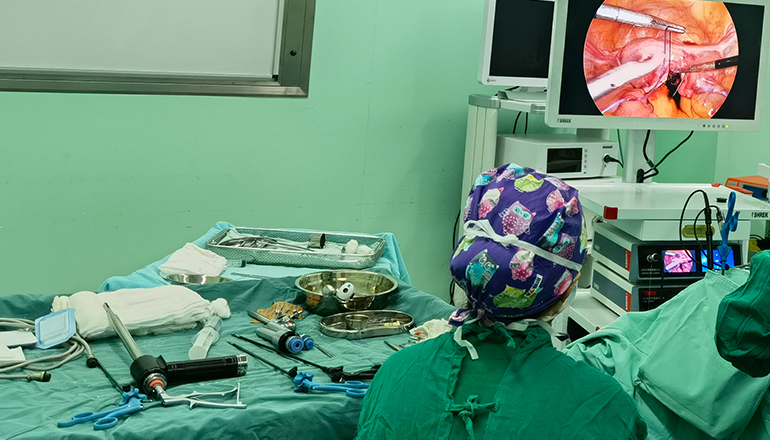- Shanghai, China
- [email protected]
- +86-21-58189111
Gynecological laparoscopy is a minimally invasive surgical procedure that allows for the examination of the pelvic organs using a laparoscope, which is a thin, flexible tube with a camera and light on the end. The procedure is commonly used to diagnose and treat a variety of gynecological conditions, including endometriosis, ovarian cysts, and fibroids.
There are several instruments commonly used during gynecological laparoscopy, including:
Trocars: Trocars are long, slender instruments used to create access ports into the abdomen. They are typically inserted through small incisions in the abdominal wall and allow for the insertion of other laparoscopic instruments.
Laparoscope: The laparoscope is a thin, flexible tube with a camera and light on the end. It is inserted into the abdomen through one of the trocar ports and allows the surgeon to visualize the pelvic organs and perform the procedure.

Graspers: Graspers are instruments used to grasp and manipulate tissue within the abdomen. They come in a variety of sizes and shapes, and may have a serrated or smooth tip depending on their intended use.
Scissors: Laparoscopic scissors are used to cut and dissect tissue within the abdomen. They may have a straight or curved blade, and come in various sizes to accommodate different procedures.
Bipolar forceps: Bipolar forceps are used to coagulate tissue and stop bleeding during laparoscopic surgery. They are designed to deliver an electrical current that coagulates tissue, without damaging surrounding structures.
Needle holders: Needle holders are used to grasp and manipulate sutures during laparoscopic surgery. They typically have a curved tip that allows for precise needle placement and manipulation.
Suction-irrigation system: The suction-irrigation system is used to remove fluids and debris from the surgical site during laparoscopic surgery. It is typically attached to the laparoscope and allows the surgeon to clear the field of vision and maintain a clear view of the surgical site.
Endoscopic stapler: Endoscopic staplers are used to close or divide tissue during laparoscopic surgery. They are designed to deliver a row of staples that close and seal the tissue, allowing for faster healing and less postoperative pain.
In summary, gynecological laparoscopy is a minimally invasive surgical procedure that utilizes several specialized instruments to diagnose and treat a variety of gynecological conditions. The most commonly used instruments include trocars, laparoscopes, graspers, scissors, bipolar forceps, needle holders, suction-irrigation systems, and endoscopic staplers. These instruments are designed to allow for precise manipulation of tissue within the abdomen, while minimizing trauma to surrounding structures and reducing the risk of complications.
It is important to note that the specific instruments used during gynecological laparoscopy may vary depending on the type of procedure being performed and the individual needs of the patient. Additionally, advancements in laparoscopic technology and techniques have led to the development of new and innovative instruments, which may offer improved precision, safety, and outcomes.
If you are scheduled to undergo gynecological laparoscopy, it is important to discuss the procedure with your healthcare provider and ask any questions you may have about the instruments and techniques used. Your healthcare provider can help you understand the benefits and risks of the procedure, as well as what to expect before, during, and after the surgery.
In summary, gynecological laparoscopy is a valuable tool for diagnosing and treating a variety of gynecological conditions. The procedure utilizes specialized instruments, including trocars, laparoscopes, graspers, scissors, bipolar forceps, needle holders, suction-irrigation systems, and endoscopic staplers, to allow for precise manipulation of tissue within the abdomen. With advancements in technology and techniques, gynecological laparoscopy is becoming an increasingly safe and effective option for patients.
Leave a Comments